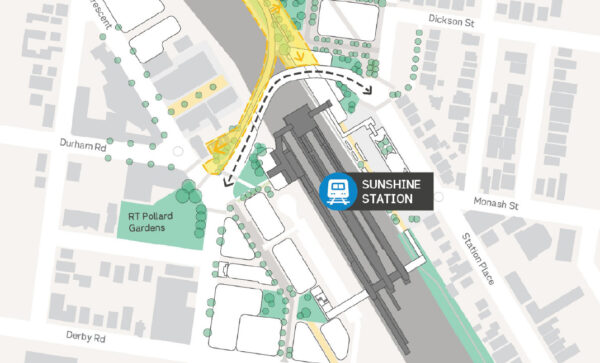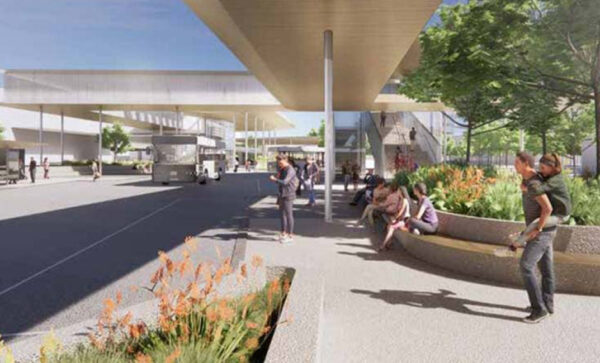By Chancy Quan
The State and Federal governments have announced a $63.5 million investment to transform Sunshine Station into a superhub similar to Southern Cross Station.

Sunshine Station already serves as a major transport interchange in Melbourne’s west, with 70 per cent of the State’s V/Line services travelling through it, and future plans will see it link up with an airport service to the CBD.
“We are rebuilding Sunshine Station once, and doing it right – saving time, cost and a huge amount of disruption for locals, businesses and everyone travelling to the station,” a Victorian Government spokesperson says.
However, some local residents say their voices have not been listened to during limited consultation processes surrounding the project. They are also critical of spending taxpayers’ money on a station that was rebuilt a decade ago.
The Sunshine Station redevelopment plan includes upgrades to platforms, tracks, and signal systems, with provisions for future trains running from Melton. Once completed Sunshine Station will accommodate six trains per hour to Tullamarine Airport.
The new funding is in addition to the Victorian Government’s $143 million Sunshine Station Precinct Masterplan, which includes a new bus interchange and pedestrian connections.
“The West has grown very rapidly, but there has been relatively less investment in public transport there compared to the East,” says Marion Terrill, a policy analyst and former Director of the Transport and Cities Program at the Grattan Institute.
“I think building capacity in the West does make sense from that perspective as a general comment.”
However Terill questions whether airport rail is the most pressing priority in terms of public transport needs for the western suburbs, especially given the costs and the alternative services already available.
“SkyBus is pretty fast, and trains going through Sunshine might actually take longer to reach the same destination. Plus, it’s a costly time to be building infrastructure right now, with limited workers and materials in such high demand.”

Former Brimbank Mayor and Greater Sunshine Community Alliance co-founder, John Hedditch, also has concerns and believes the proposal lacks key infrastructure.
“It [the plan] doesn’t have any escalators, despite there being a big aging population,” says Hedditch.
“People coming through to Sunshine from the airport or on the metro tunnel and wanting to change over to get on regional trains or other city bound trains won’t have any sort of decent public toilets or amenities for mothers to change babies.”
“There’s very little weatherproofing on the platforms at all … There’s going to be weather events … So I guess those sort of things about the station itself are problematic.”
“I might be positive about proposed developments, but this one’s got too many things wrong with it.” he says.
What are local concerns over the rebuild?
Another point of contention for locals is the proposed closure of the Hampshire Road overpass ramps. The redevelopment will change it from a general traffic zone into a pedestrian zone which residents argue will create traffic hazards and congestion.
Wally Haering, who monitors traffic flow on the northbound ramp, says there are approximately 600 vehicle movements per hour in peak periods.
“This amount of traffic [will be] forced through Withers Street, Dickson Street and Devonshire Road, a convoluted street network in the southern Sunshine CBD,” Haering says.
“The road closure will only cause gridlocks and serve no benefit.”
Haering also points to issues with proposed walkway gradients, arguing they exceed Australian Standards for accessibility.
“These ramps are too steep for walkways that are dangerous for seniors, parents with prams, and people with disabilities.”
Joel Bentley, a Sunshine local of over six years, worries that additional platforms and tracks might reduce the parking capacity on either side of the station and cause chaos.
“Not everyone can walk to the station, especially for elderly people and people with kids,” he says.
“I think it’s a decision that’s been made without the right level of consultation with people who need to live and work in the area or use the station precinct, which is disappointing.”
The president of the Rail Futures Institute, John Hearsch, expects that the government will expand parking closer to the Melbourne end of the station to compensate for the anticipated reduction of parking spaces on the southern side.
“Sunshine Station should be upgraded and could be an important hub. But my concern is whether the government’s plans will actually achieve that.”
Hearsch says the government needs to provide the latest details about the plan.
State Member for Laverton, Sarah Connolly, says the Sunshine Station needs to be bigger to accommodate the role of a superhub, which will not only service the airport but also provide more services on the Geelong, Bendigo, Ballarat and Wyndham Vale V/Line trains.
While some residents believe that the money would still be better spent on improving hospital care, mental health services, housing, and upgrading other nearby stations like Albion and Tottenham, Connolly cites existing investment in health and housing across Melbourne’s western suburbs.
“Sunshine Hospital recently received a major upgrade in the form of the Joan Kirner Women’s and Children’s Hospital. We’re also getting on with building a new $1.5 billion Footscray Hospital – the biggest health spend in Victorian history,” Connolly says.
“Regarding housing, our Government has invested $5.3 billion into building and upgrading 12,000 social and affordable homes across Victoria.”
In 2022, the government pledged $80 million for Albion Station redevelopment, but its future, along with the current Sunshine Station upgrade, has become uncertain due to delays in the Melbourne Airport Rail Project.


Too many bloody whingers the rail corridor is and always has been needed. All rail from the North should come through Sunshine not Broadmeadows. There is an opportunity to build a flailing sunshine into something special. There is plenty of land that can also be developed in the area around the station. Time people thought about the future